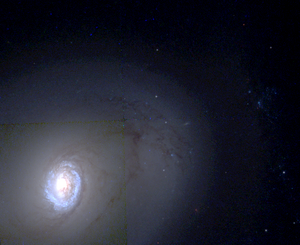NGC 1326
| Galaxy NGC 1326 |
|
|---|---|

|
|
| Photo from the Hubble Space Telescope | |
| AladinLite | |
| Constellation | Chemical furnace |
|
Position equinox : J2000.0 , epoch : J2000.0 |
|
| Right ascension | 03 h 23 m 56.4 s |
| declination | -36 ° 27 ′ 53 ″ |
| Appearance | |
| Morphological type | (R_1) SB (rl) 0 / a / LINER |
| Brightness (visual) | 10.5 mag |
| Brightness (B-band) | 11.4 mag |
| Angular expansion | 3.9 ′ × 2.9 ′ |
| Position angle | 77 ° |
| Surface brightness | 13.0 mag / arcmin² |
| Physical data | |
| Affiliation | Fornax cluster LGG 96 |
| Redshift | 0.004537 ± 0.000005 |
| Radial velocity | 1360 ± 1 km / s |
|
Stroke distance v rad / H 0 |
(55 ± 4) · 10 6 ly (17.0 ± 1.2) Mpc |
| history | |
| discovery | John Herschel |
| Discovery date | November 29, 1837 |
| Catalog names | |
| NGC 1326 • PGC 12709 • ESO 357-026 • MCG -06-08-011 • IRAS 03220-3638 • 2MASX J03235639-3627527 • SGC 032201-3638.4 • GC 706 • h 2535 • HIPASS J0323-36 • FCC 29 • LDCE 249 NED004 | |
NGC 1326 is a lenticular galaxy with an active nucleus of the Hubble type SB0 in the constellation Fornax in the southern sky . It is an estimated 55 million light years away from the Milky Way and has a diameter of about 65,000 ly. It is listed as a member of the Fornax galaxy cluster under catalog number FCC 29 .
In the same region of the sky there are u. a. the galaxies NGC 1310 , NGC 1316 , NGC 1317 and NGC 1341 .
The object was discovered on November 29, 1837 by John Herschel with his 18.7-inch telescope .
Web links
Commons : NGC 1326 - collection of images, videos, and audio files
- SIMBAD Astronomical Database
- ESO: Image of the region of the sky around NGC 1316 (labeled) October 25, 2017
- Spektrum .de: amateur recordings [1]
Individual evidence
- ↑ a b c d e NASA / IPAC EXTRAGALACTIC DATABASE
- ↑ a b c d e SEDS : NGC 1326
- ^ VizieR
- ↑ Seligman ( Memento of the original from September 10, 2015 in the Internet Archive ) Info: The archive link was inserted automatically and has not yet been checked. Please check the original and archive link according to the instructions and then remove this notice.
